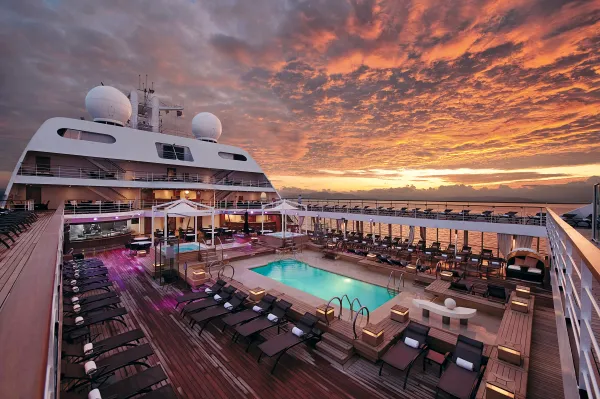Mexico to Phase In Cruise Passenger Tax, Starting at $5 in 2025
Mexico’s gradual cruise passenger tax aims to balance essential port upgrades with continued strong tourism, giving cruise lines and local businesses time to adjust without disrupting the market.

Mexican authorities have announced a revised rollout of the Non-Resident Duty for cruise passengers, shifting from an originally proposed $42 flat fee to a phased schedule beginning at $5 per person in 2025. This measure, negotiated with the Florida-Caribbean Cruise Association (FCCA), aims to fund port maintenance and tourism-related services in destinations such as Cozumel, Costa Maya, Cabo San Lucas, and Puerto Vallarta without compromising Mexico’s competitive edge in the Caribbean market.
Phased Rollout and Revised Tax Schedule
Under the new agreement, the Non-Resident Duty will be introduced gradually:
- $5 per passenger starting July 1, 2025
- $10 per passenger from August 1, 2026
- $15 per passenger by July 2027
- $21 per passenger by late 2028
These fees will be incorporated into cruise fares as part of existing port taxes, sparing passengers from separate, on-site payments. Cruise lines have considerable lead time to update their pricing structures, minimizing abrupt cost increases that could deter potential travelers.
Industry Negotiations and Official Statements
The FCCA, representing nearly all major cruise operators serving Mexico, led in-depth discussions with government officials to tone down the originally proposed $42 levy. Following the announcement of the phased plan, the FCCA stated, “We thank the Federal Government of Mexico for collaborating with us to protect cruise tourism and generate sustainable benefits for local communities.” Federal Tourism Secretary Josefina Rodríguez described the agreement as “a vital step in fostering Mexico’s economic development and supporting its ports.”
Carnival Corporation CEO Josh Weinstein also affirmed the positive nature of the negotiations, citing productive conversations with the governor of Quintana Roo, a region where tourism revenue is deeply entwined with cruise arrivals.
Economic Implications and Local Port Impact
Mexico expects over 10 million cruise passengers annually, generating significant revenue for local businesses. According to the FCCA, direct spending from cruise tourism contributed around $1 billion in 2023. By reducing and phasing in the tax, the government aims to secure essential funding for infrastructure projects, including ongoing port maintenance and proposed expansions like a larger pier in Cozumel, all while maintaining high visitor numbers.
Analysts view the plan as a safeguard against losing ships to nearby Caribbean ports, which might have become more competitive had the fee remained at $42. With the phased structure in place, local economies are anticipated to benefit from sustained visitation, and cruise lines have pledged to increase passenger numbers, source more goods locally, and explore further investment opportunities in Mexican destinations.
Implementation and Cruise Line Fare Adjustments
Cruise operators generally include government taxes and port fees in the base fare, so travelers will see the Non-Resident Duty reflected in published cruise prices. Any adjustments for bookings made well in advance typically appear as revised tax line items or onboard statements. Guests requiring specific fee details are advised to consult their cruise line directly.
Royal Caribbean, for example, continues to enhance its presence in Mexico through new attractions. The Royal Beach Club in Cozumel is slated to open in 2026, followed by a “Perfect Day” destination in Costa Maya in 2027. These initiatives highlight broader industry confidence that Mexico’s cruise sector will remain highly popular among international visitors.
Cruise Lines Response
Despite initial concern over a steep tax hike, industry leaders have largely expressed relief at the compromise. Beyond Carnival Corporation’s and Royal Caribbean’s expansion plans, the broader cruise sector remains optimistic about Mexico’s future as a leading cruise destination. The gradual fee escalation offers opportunity for long-term itinerary planning, ensuring that both local communities and cruise companies adapt at a manageable pace.
Frequently Asked Questions (FAQs)
Why did Mexico initially propose a $42 cruise passenger tax?
The original levy aimed to raise funds for port infrastructure and tourism-related services by including all foreign visitors under the Non-Resident Duty. Cruise passengers had previously been exempt, prompting authorities to explore new revenue streams. However, industry pushback led to negotiations that produced the phased-in approach.
What is the phased rollout schedule for the new tax?
Beginning July 1, 2025, the duty starts at $5 per passenger. It increases to $10 from August 1, 2026, rises to $15 by July 2027, and reaches $21 by late 2028.
Will passengers pay the fee directly, and how will cruise lines handle it?
Passengers will not pay the fee separately upon arrival. Cruise lines will incorporate the tax into the existing port fees category within published fares. Any overestimation typically appears as onboard credit or adjusted on guest statements.
How will the tax impact cruise tourism and local economies?
By phasing in the fee, Mexico aims to prevent sudden price spikes while still generating revenue for port improvements. Analysts and tourism officials predict that maintaining a gradual schedule will help sustain demand, support local businesses, and preserve Mexico’s competitiveness among Caribbean destinations.
Which ports in Mexico does the tax apply to?
The Non-Resident Duty applies to all international cruise passengers calling at Mexican ports, including popular stops like Cozumel, Costa Maya, Cabo San Lucas, and Puerto Vallarta.
As Mexico navigates the shift into peak cruising seasons over the coming years, this phased tax structure is widely expected to protect key revenue streams while fostering long-term investments in port infrastructure and local tourism services.




